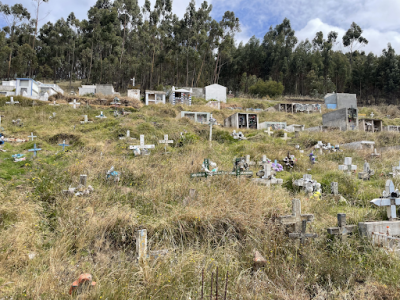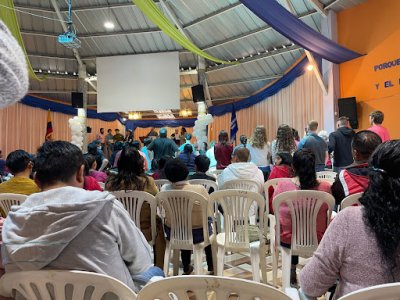Funerals and Worship
As is often the case on SST, I found myself one afternoon on a bus with essentially no knowledge of where I was going. My mom quickly explained that we were headed to a funeral, and I became concerned. “Did you know her well”, I asked my host brother. “No, we never met”, he replied.
Suddenly I was in a small Catholic church filled with dark wood, porcelain-white figurines of Jesus and Mary, and haunting music. I have grown accustomed throughout SST to standing out in a crowd, but I felt especially unique in this situation. Often there are a few other foreigners around, but as I glanced around it was evident that I was the sole foreigner among around 150 people. And as a Mennonite, I couldn’t hide my lack of prior knowledge about Catholic rituals and chants, especially given that it was in Spanish.
After the service ended my host brother explained, “We’re going to eat,” and I excitedly followed the crowd out of the sanctuary, expecting to enter some type of church kitchen. Instead, everyone filed out of the church and began to walk uphill on a cobblestone path into the surrounding mountains. Before long, we reached a cemetery filled with small gray crosses and plastic flowers.
I watched as someone prayed over the casket—clearly, the burial process was beginning, something that I hadn’t seen in over a decade. Unlike in the US, it was clear the entire crowd was going to be present for the burial. There were so many people that it was impossible to hear the prayer or see what was going on, but I perched on a cement block and watched.
Suddenly, I noticed that buckets of tan liquid were being passed around, and I was handed a cup. “It’s chicha (a fermented corn drink)”, my brother explained. I watched as indigenous men downed the liquid cup by cup and began sipping my own until my stomach burned.
Several people began distributing bread and crackers on a blue bedsheet. A box of banana halves came next, and finally, gray tubs of unseasoned chicken, potatoes, and corn were passed out. Everyone sat contentedly on the hillside of the cemetery, amongst the graves, and we ate together as dirt was shoveled over the casket.

Here’s the cemetery where the burial took place.
Although I felt uncomfortable at points during this experience, I was also amazed at the beauty of the way that the indigenous community joined together to celebrate the deceased and even shared a meal together. One of my favorite aspects of being here in my service region has been getting a remarkable glimpse into the indigenous population of Ecuador.
One other religious experience that I’ve had on service stands out to me but in a much more joyful atmosphere. I attend an evangelical church every Sunday with my host family, and one week, I was shocked to see a large group of Americans there too. They were promptly introduced as a group from Pleasant View Church, an Anabaptist Evangelical church from Goshen!

Members of Pleasant View Church from Goshen worship alongside members of my evangelical church.
This funny Goshen coincidence gave me another opportunity to reflect on how religion and community reinforce each other, albeit in a very different way than the funeral. It reminded me that “church” is not simply a building that people meet in weekly, but has a much broader scope. Shared faith allowed two groups from very different backgrounds who speak different languages to worship together. Likewise, it provided a foundation for a large community to mourn and celebrate life together.




